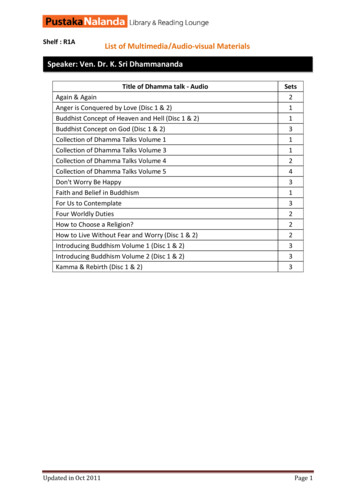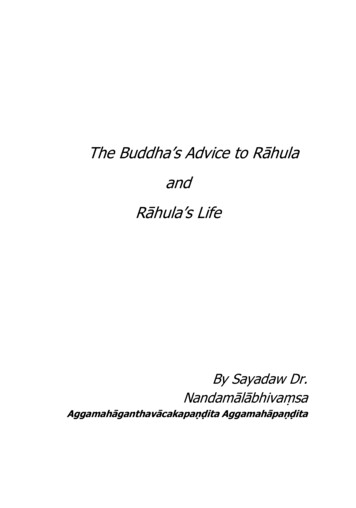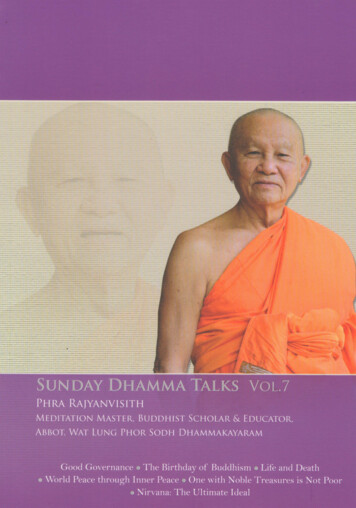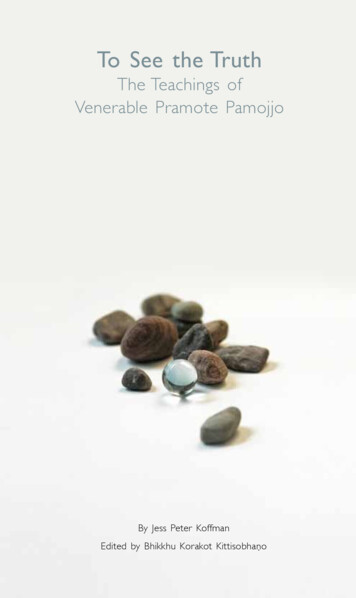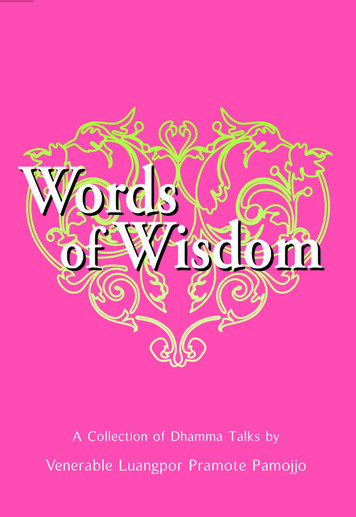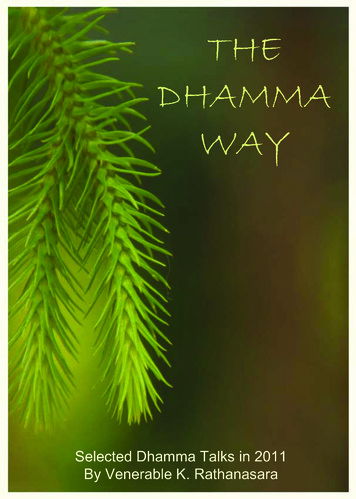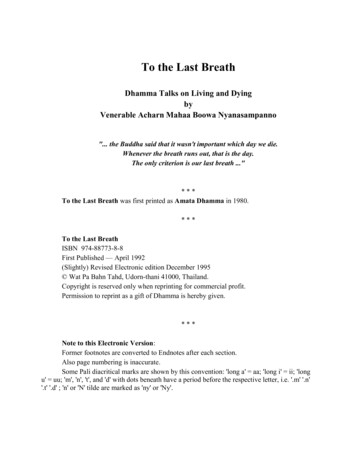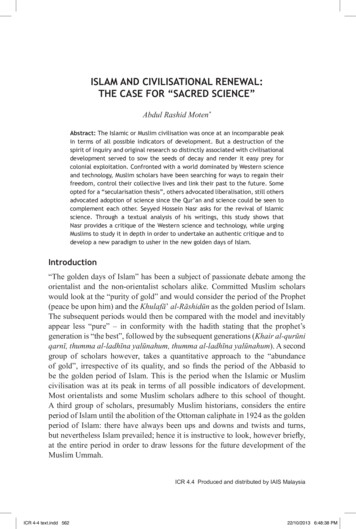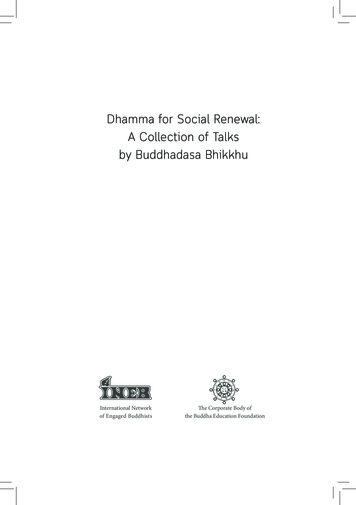
Transcription
Dhamma for Social Renewal:A Collection of Talksby Buddhadasa BhikkhuInternational Networkof Engaged BuddhistsThe Corporate Body ofthe Buddha Education FoundationBuddhadasa Bhikkhu1
Dhamma for Social Renewal:A Collection of Talks by Buddhadasa BhikkhuBuddhadasa BhikkhuTranslated from the Thai by Donald K Swearer 2019 by Donald K SwearerAll rights reserved.ISBN RequestedFirst edition – July 2019, 1,000 impressionsPrinted and disseminated as a gift of Dhamma, this book is without royalties. Thepurpose of the copyrighting is to protect the accuracy of its contents in each printingof the book. Any party interested in publishing this work is, therefore, requested toask for permission and obtain a copy of the manuscript for the latest version.International Network of Engaged Buddhists (INEB)666 Charoen Nakorn RoadKlongsan, Bangkok 10600 Siamwww.inebnetwork.orgEdited by Rita A. Litwiller and Jonathan S. WattsCover design and layout by Surapong PetnamlaiCover image taken from a painting of Buddhadasa Bhikkhu by Hongjorn SanengamJaroenPrinted for free distribution byThe Corporate Body of the Buddha Education Foundation11F, No. 55, Sec. 1, Hang Chow South Road, Taipei, Taiwan, R.O.C.Tel: 886-2-23951198, Fax: 886-2-23913415Email: overseas@budaedu.orgWebsite: http//www.budaedu.orgMobile Web: m.budaedu.orgThis book is strictly for free distribution, it is not to be sold.2Dhamma for Social Renewal:A Collection of Talks
Dhamma for Social Renewal:A Collection of Talksby Buddhadasa BhikkhuTranslated from the Thai byDonald K SwearerForeword by Sulak SivaraksaBuddhadasa Bhikkhu3
Table of ContentsForeword by Sulak Sivaraksa6Introduction: The Challenging Vision8of Buddhadasa Bhikkhu by Donald K SwearerBuddhism and HumanityThe Right Action to be Truly Fully Human19The Foundation of What It Means to be Human33The Goal of Life41The Best Way to Proceed with Our Lives45Dhamma for the Mature53The Reason Buddhists Misunderstand the Principles of Buddhism67The Best Way to Describe Nibbāna is the End of Suffering73Who’s Suffering? Who’s Happy?75Wisdom77Buddhism and Not-SelfThe Crisis that is Threatening the World81Not-Self: A Superior Way to Limit Selfishness85The Scope of the Problems Regarding the Self91Selfishness is Very Frightening95Spiritual Disease99Destroying Selfishness101The Way to Salvation is the Elimination of Selfishness105Buddhism and Religion4What is Religion?111Religion is the Hospital of the World115Dhamma for Social Renewal:A Collection of Talks
Nurturing Religion121Promoting Understanding among Religions127A Good Buddhist is Likely to be a Good Christian135Nibbāna Means Being Freed From Bondage145Nibbāna: The Salvation of Humankind147Buddhist PracticeMindfulness155Mindfulness is Necessary Continuously161Separation163Giving that Does Not Require Money but Attains Nibbāna165Good Friends171The Technique for Being Human173Buddhist Culture177A Buddhist Perspective on Education and Receiving a Diploma179Authentic Ordination, Study and Practice Produce Authentic Results 183Buddhism and SocietyA Socialism that Can Help the World191Buddhists and the Care of Nature195Work is Practicing Dhamma201Work for the Sake of Work203Working for Society with a Liberated Mind213About the Author218About the Translator219Buddhadasa Bhikkhu5
ForewordDon Swearer was never ordained at Suan Mokkh, but he is a brilliant scholarof Buddhadasa Bhikkhu’s life and works. He had even recommended therevered monk to divide his sermons into series, keep an audio recording ofeach and every one of them, and compile and transform them into book formlater. Since Buddhadasa took up Ajarn Don’s suggestion, we now have asizeable collection of his works—a real treasure.A young American who took the ordained name Santikaro thenoften served as Buddhadasa’s interpreter. After leaving the monkhood,Santikaro has become the leading translator of Buddhadasa’s works, especiallyfor readers in the United States. By comparison, some Western scholars whoclaim to be Buddhadasa experts possess only superficial understanding ofhim.Buddhadasa’s works have been translated into many differentlanguages, including Chinese and Japanese. He is also the subject of numerousbooks. To my knowledge, Louis Gabaude of the Ecole française d’ExtrêmeOrient has compiled the most complete bibliography of works on or citingBuddhadasa in various languages.After retiring from Swarthmore College and the Center for theStudy of World Religions at Harvard Divinity School, Ajarn Don still regularlytranslates and writes on Buddhadasa for the Western audience—an admirablefeat. Some of his pieces can be found in our Seeds of Peace magazine.In this book, Ajarn Don shows us the links between Buddhadasa’sand Thich Nhat Hanh’s teachings. The latter is a progenitor of socially engagedBuddhism. In fact, Buddhadasa admired Nhat Hanh’s writings, even insistingthat they are more poetic and eloquent than his own.When we first established the International Network of Engaged6Dhamma for Social Renewal:A Collection of Talks
Buddhists (INEB) in 1989, both of these monks agreed to be our patrons; andso too did His Holiness the Dalai Lama.The publication of this book in Taiwan is made possible by thegoodwill of the local Buddhists. Of course, it will be translated into Chinese,too.I would like to express my sincere gratitude to Ajarn Don Sweaternot only for compiling and translating this book, but also for the years offriendship and support. I became well-known in the United States primarilybecause of his contribution in Engaged Buddhism: Buddhist LiberationMovements in Asia, ed. Christopher S. Queen and Sallie B. King (StateUniversity of New York Press, 1996). He was also the main reason why Ibecame Distinguished Visiting Professor for Social Change at SwarthmoreCollege and Senior Fellow in Residence at the Harvard-Yenching Institute.In this book, Ajam Don has selected and translated a number ofpieces by Buddhadasa. In the Introduction, he has already provided anexplanation and commentary on them. I have nothing more to add. I wouldlike to thank him as well as Thai and Taiwanese kalyanamitta for publishingthis book which commemorates Buddhadasa Bhikkhu’s birthday on 27 May2019.Sulak SivaraksaBuddhadasa Bhikkhu7
Introduction:The Challenging Vision ofBuddhadasa BhikkhuDonald K. SwearerDhamma is acting as we should act in order tobe fully human throughout all the stages of ourlives. Dhamma means to realize our fullestpotential as individual human beings. What ismost important is to realize that Dhamma is notsimply “knowing,” but also “acting” in the truestsense of what it means to be human.Buddhadasa Bhikkhu,Kankratham Thī Thudong Kae Quam Pen Manut[The Right Action To Be Human]Phra Dhammakosacarya (Nguam Indapañño), better known as BuddhadasaBhikkhu (May 27, 1906 – May 25, 1993), was one of the most creative 20thcentury thinkers in Thai Theravada Buddhism. Only a small portion of theextensive Buddhadasa corpus has been translated from Thai into English andother European languages, hence, the importance of this volume of essaysthat elucidate one of the major foundational themes in Buddhadasa’s thought,namely, “That nothing whatsoever should be clung to as ‘I’ and ‘Mine’;” or, asBuddhadasa reiterates in one of his favorite Pali phrases, “Sabbe dhammanalam abhinivesaya” (“Nothing whatsoever should be clung to”). The conceptwhich epitomizes non-clinging for Buddhadasa is suññatā, translated in this8Dhamma for Social Renewal:A Collection of Talks
volume as “voidnesss,” but it is equally true that for Buddhadasa the essentialmeaning of the Four Noble Truths, anattā, paṭicca-samuppāda, Nibbāna, andeven Buddha embody non-clinging. The heart of Buddhism is the quenchingof suffering (dukkha), a condition that cannot be achieved withoutovercoming blind attachment and ignorance.The core of Buddhadasa’s teaching might be summarized as follows:The individual is not-self (anattā). As such s/he ispart of an on-going, conditioning process (paṭicca-samuppāda) devoid of self-nature (suññatā), aprocess to which words can only point (bhāsa-dhamma). This process functions according touniversal principles we call nature (dhammajāti). Itis the true (saccadhamma), normative (pakati),moral (sīladhamma) condition of things. To be notself (anattā), therefore, is to be void (suññatā) ofself, and, hence, to be part of the interdependentco-arising matrix (paṭicca-samuppāda) of all things,and to live according to the natural moral order(sīladhamma) in a community voluntarily restrained(dhammika sangama-niyama) by other-regardingconcerns.A dynamic, critical thinker who eschewed the Buddhist Sanghamainstream, Buddhadasa rejected all absolutisms in a manner consistentwith his foundational principle of non-clinging. He was especially critical ofideological absolutism and religious idolatry, and was an advocate forenvironmental preservation and social justice.Buddhadasa Bhikkhu9
The Challenge of Ideological AbsolutismBuddhadasa’s theory of two languages or two levels of language (Thai. phasakhon/phasa tham)—an outer, physical, literal, conventional dimension andan inner, spiritual, symbolic dimension—challenges textual and doctrinalliteralism, and simplistic, doctrinaire ideologies.In his essay, Phāsā Khon/Phāsā Tham (Everyday Language/DhammaLanguage), Buddhadasa analyzes the meaning of many terms, somespecifically religious, such as God, Buddha, Dhamma, Nibbāna; but alsoordinary words as well, such as “person.” In everyday language, “person”refers to the outer form as in the sentence, “We see a person walking downthe street.” However, in Buddhadasa’s view, to limit our understand of“person” to the superficial, outer form ignores the profundity of the Dhammalevel meaning of the word. At this level, “person” refers specifically to specialqualities implied by the word, “human;” in particular, the mental qualities ofa lofty mind or high mindedness.Buddhadasa’s teaching about phāsā khon/phāsā tham resonateswith Thich Nhat Hanh, one of the founders of Socially Engaged Buddhismduring the Vietnam war. During that time, Nhat Hanh organized the TiepHien Order (“being-in-touch/present time”) or Order of Interbeing. The firstof the fourteen precepts of the Order of Interbeing is the following: “Do notbe idolatrous about or bound to any doctrine, theory, or ideology, evenBuddhist ones. All systems of thought are only guiding means; they are notabsolute truth.” In explaining the precept, Nhat Hanh points to the wellknown metaphor that the Buddha’s teaching is a raft to cross the river ofsamsāra to the farther shore; the raft is not the shore, and if we cling to theraft we miss everything. He continues, “The Order of Interbeing was born inVietnam during the war, which was a conflict between two world ideologies.In the name of ideologies and doctrines, people kill and are being killed. Ifyou have a gun, you can shoot one, two, three, five people; but if you have an10Dhamma for Social Renewal:A Collection of Talks
ideology and stick to it, thinking it is the absolute truth, you can kill millions.”(Being Peace) Nhat Hanh and Buddhadasa Bhikkhu are constructive criticsof ideological absolutism and scriptural literalism.The Challenge of Religious IdolatryBuddhadasa holds the view that the world’s great religions, while differenthistorically, share a common ground. In his provocative Dhamma talk MaiMī Sasana (No Religion!), Buddhadasa startled his Thai Buddhist audience bysaying:The ordinary, ignorant worldling is under theimpression that there are many religions and thatthey are all different to the extent of being hostileand opposed. Thus one considers Christianity, Islam,and Buddhism as incompatible and even bitterenemies. Such is the conception of the worldlyperson who speaks according to ordinary impressions.Precisely because of such characterizations, thereexist different religions hostile to one another. If,however, people penetrate to the fundamentalnature (dhamma) of religion, they will regard allreligions as essentially similar. Although they maysay there is Buddhism, Christianity, Islam, and so on,they will also say that essentially they are the same.If they should go on to a deeper understanding ofdhamma until finally they realize the absolutetruth, they shall discover that there is no suchthing called religion—that there is no Buddhism,Christianity, or Islam. Therefore, how can they bethe same or conflicting?Buddhadasa Bhikkhu11
Buddhadasa made a similar claim in his Sinclair Thompson lectures deliveredat McGilvary Theological Seminary, Chiang Mai, Thailand, in 1967 (B. E.2510):Christianity and Buddhism are both universalreligions; they exist wherever truly religious peoplepractice their religion in the most perfect way. Ifreligious persons show respect for each religion’sfounder and for the Dhamma-truth at the core ofeach religion, they will understand this interpretation.Devotion to a religion results in the cessation ofself-interest and self-importance and thereforeleads to a realization of the universality and unityof all religions.Buddhadasa’s inclusive universalism is an expression of hisconviction that nonattachment lies at the heart of Buddhism and all religions.Preoccupation with the external trappings of religious institutions and theirritual ceremonies represents a particular form of attachment and,consequently, obscures the true meaning of religion, which is to transformegoism into altruism. In the case of conventional Thai Buddhist practice,Buddhadasa directs especially sharp criticism at the practice of merit-makingrituals: “The perception of most adherents of Buddhism is limited to whatthey can do to get a reward. The heart of Buddhism is not getting things butgetting rid of them. It is, in other words, nonattachment.” For Buddhadasa,when we cling to external, outer, physical forms, we see everything in dualisticterms—good or evil, merit or sin, happiness or unhappiness, gain or loss, isor is not, my religion versus their religion. Such dualistic thinking is at theheart of religious conflict. Buddhadasa’s universalism counters such a view.12Dhamma for Social Renewal:A Collection of Talks
The Challenge of Environmental DestructionBuddhadasa’s concept of nature (Thai. thammachat) as Dhamma (Thai.thamma pen thammachat) challenges conventional attitudes and actionsregarding the care of the earth. It was Buddhadasa’s perception of theliberating power of nature-as-Dhamma that inspired him to found theGarden of Empowering Liberation (Wat Suan Mokkh) as a center of teachingand practice in Chaiya, southern Thailand. For Buddhadasa the naturalsurroundings of his forest monastery were nothing less than a medium forpersonal transformation:Trees, rocks, sand, even dirt and insects can speak.This doesn’t mean, as some people believe thatthey are spirits (phi) or gods (thewada). Rather, ifwe reside in nature, near trees and rocks, we’lldiscover feelings and thoughts arising that aretruly out of the ordinary. At first we’ll feel a senseof peace and quiet, which may eventually movebeyond that feeling to a transcendence of self. Thedeep sense of calm that nature provides throughseparation from the troubles and anxieties whichplague us in the day-to-day world serves to protectheart and mind. Indeed, the lessons nature teachesus lead to a new birth beyond the suffering(dukkha) that results from attachment to self. Treesand rocks, then, can talk to us. They help usunderstand what it means to cool down from theheat of our confusion, despair, anxiety, andsuffering.Buddhadasa Bhikkhu13
For Buddhadasa, it is only by being in nature that the trees, rocks,earth, sand, animals, birds, and insects can teach us the lesson of selfforgetting—being at one with Dhamma. The destruction of nature, then,implies the destruction of Dhamma, and the destruction of Dhamma is thedestruction of our humanity.The Challenge of Social JusticeTime and again in his writings Buddhadasa challenges conventional, literal,narrow understandings of Buddhism and all religions in favor of universalprinciples of human development, not just identifying oneself as a ThaiBuddhist, an American Christian, or an Iranian Muslim but as a humanbeing. His interpretation of the Four Noble Truths—as nature (thammachat),the laws of nature, the duty of humankind to live according to the laws ofnature, and the consequences of following the laws of nature—reflects hisview that all human beings share a common natural environment and arepart of communities imbedded in the natural order of things. Thisinterconnected universe we inhabit is the natural condition of things (pakati).To act contrary to this law of nature is to suffer (dukkha), because suchactions contradict reality. Consequently, the good of the individual parts ispredicated on the good of the whole and vice versa.The ethical principle of the good of the whole is based on the truthof interdependent co-arising (paṭicca-samuppāda). Nothing exists inisolation; everything co-exists interdependently as part of a larger wholewhether human, social, cosmic, or molecular: “The entire universe is aDhammic community (dhammika sangkhom). Countless numbers of stars inthe sky exist together in a dhammika sangkhom. Because they follow theprinciples of a dhammika sangkhom, they survive. Our small universe withits sun and planets including the earth is a dhammika sangkhom.”Buddhadasa’s view of a dhammika sangkhom reflects his persistent14Dhamma for Social Renewal:A Collection of Talks
emphasis on overcoming attachment to self, to “me-and-mine” (Thai. tua kukhong ku). Fundamentally, both personal and social well-being result fromtransforming self-attachment and self-love to empathy toward others andsympathetic action on their behalf. A dhammika sangkhom, then, is acommunity based on the fundamental equality of all beings that both affirmsbut transcends all distinctions be they gender, ethnicity, or class. Such a viewdoes not deny the existence of differences among individuals or groups;however, all people, regardless of position and status, should understand thattheir own personal well-being depends on the well-being of all.Buddhadasa Bhikkhu15
16Dhamma for Social Renewal:A Collection of Talks
BuddhismandHumanityBuddhadasa Bhikkhu17
18Dhamma for Social Renewal:A Collection of Talks
The Right Action to beTruly Fully HumanThe term Dhamma is of great value and has been widely debated. Everyonehas the sense that Dhamma is something superlative. If Dhamma were not soregarded--something excellent, precious, and valuable--then it would not beso widely discussed.I assume that all of you here are acquainted with the subject ofDhamma. I am not going to consider that some of you know Dhamma andothers do not, or that some of you know a lot about Dhamma and others verylittle. Therefore, I will summarize Dhamma so that it will be relevant for all ofyou [regardless of your previous knowledge.]Consider my remarks as a New Year gift since in two or three days,it will be the New Year. I am taking this opportunity to impart knowledgeabout Dhamma as a New Year gift to all of you. Make Dhamma moreimportant in your lives in the New Year, not in the sense of repeatedly goingaround in circles [about Dhamma] but, rather, systematically going forward.The years pass by and we mark the time without truly understandingDhamma. Therefore, I am going to address the topic of Dhamma so that youBuddhadasa Bhikkhu19
can more clearly understand it and progress in your knowledge of Dhammarather than simply going around in the same old circles.I have often spoken about the meaning of Dhamma but some havenot listened; others have forgotten what I have said; some may rememberabout half or perhaps a bit more. Be that as it may, however, I fear that youhave not really grasped the meaning I have tried to convey: Dhamma is beinghuman in the fullest sense. Dhamma is acting in accord with the highest normof what it means to be human.“What is Dhamma?” may be a question some of you are askingyourselves at this very moment and thinking in terms of what you have heardbefore or believed. For example, that Dhamma means the words taught by theBuddha or what monks preach from the pulpit. Such an understanding isinadequate; it is Dhamma as truth [or in principle.] If each of you gatheredtogether here today can help one another to remember the principles of Dhamma,then Dhamma will become increasingly a part of your lives. [In my remarkstoday I shall be discussing the fundamental norms or principles of Dhamma.]Dhamma is acting as we should act in order to be fully humanthroughout all the stages of our lives; Dhamma means to realize our fullestpotential as individual human beings. This way of understanding Dhammamay sound odd in comparison with what you have previously heard orbelieved, e.g., that Dhamma means the words taught by the Buddha. What ismost important is to realize that Dhamma is not simply “knowing,” but also“acting” in the truest sense of what it means to be human. It means integratingknowing and acting. It requires study to be able to act correctly in order tomaximize our fullest humanity in every stage of our development. Wecontinuously develop from the time of our birth to the present moment andso on until we enter the next life.We can divide our present existence into stages: childhood, adulthood,old age. We should be and act in each stage so as to realize our fullest human20Dhamma for Social Renewal:A Collection of Talks
capacity. This is the answer to the question, “What is Dhamma?” The mainprinciple is that we should strive to become fully human at every stage of ourdevelopment. When you review your life, consider whether at each stage youhave progressed on the path of becoming fully human, or in an even moredetailed way when you were one, two, or three until you reach fifteen orsixteen, twenty, thirty, fifty, or sixty. If you often cause someone to weep, ormake things difficult for your parents or neighbors, then you are not actingaccording to the highest norm of humanity.You should test yourself honestly and with a pure mind. Being selfcentered and selfish is not Dhamma. You must understand Dhamma as it isas a fundamental principle of life [rather than as speculation, hearsay, or merewords]. There is an endless debate about the “correct” understanding of Dhamma.The debate should conclude with the rule that “correct” should be that whichis useful (Thai. prayot) to both oneself and others [italics added]. If Dhamma doesnot have such an inclusive relevance, then Dhamma is not correctly understood.“Useful,” in this sense, means that which brings happiness, resolves theproblematic of suffering (dukkha), and promotes peace [italics added].Our personal existence is inherently linked to the utility of others.Our own happiness and well-being is bound up with the happiness and wellbeing of those around us. Our own peace and happiness and the peace andhappiness of the world are interdependent. We conjointly share in thefundamental quest of magga-phala-nibbāna.1 Consider for a moment, the1For Buddhadasa, being fully human includes the existential affirmationthat all sentient beings share a universal human condition and thesame aspirations characterized in Buddhist terms by the four pathscalled magga (stream-enterer, once-returner, never-returner, arahant),their fruits (phala), and the summum bonum of human aspiration,Nibbāna.Buddhadasa Bhikkhu21
meaning of happiness. Is it a state of being characterized by equanimity(coolness) or heated agitation (fire)? In terms of the Thai language, is ourhappiness spelled with a “kh” (Thai. sukh, rest, peace, well-being, happiness)or with a “k” (Thai. suk, cooked, ripe).2 Is our happiness the result of beingsatisfied with enough (Thai. pho cai) or bloated and overstuffed (Thai. uet-at).Is it the fire of passion, hatred, fear, jealousy, and foolish stupidity that cannotbe quenched or restrained? Is it suk with a k, to be enflamed? One mustscrutinize oneself to determine whether one’s happiness is with a “k” or a“kh,” based on satisfaction associated with bloated, enflamed desires or thecool of equanimity, enoughness, and sufficiency.Our world today is stressed out (Thai. khried) in virtually all aspects-health, economy, community, politics, competition among individuals andgroups, destructive envy, jealousy, and hatred. Our world lacks the beautythat brings joy. The daily newspapers are full of stories about wars rampantthroughout the world, conflict, poverty, chaos. On the individual level theseconditions are a result of a sickness of the spirit (viññāna), mind and heart(Thai. cit-cai)3 that lack purity, illumination, calm, and equanimity; that2Buddhadasa is an agent provocateur, par excellence. His skill in provokinghis audiences to think more deeply about the spiritual truths he is tryingto convey is seen in his use of irony, metaphor, and word play. In this casehe is using a word in Thai that is pronounced the same but spelleddifferently and with very different meanings: refreshing cool vs. firey hot,equanimity vs. inflamed passion.3In Thai, the compound cit-cai conveys the intimate connection betweenmind and heart, thought and sentiment/affection. I have chosen totranslate the term as “mind and heart,” rather than “heart-mind,” orsimply “mind,” or “heart.”22Dhamma for Social Renewal:A Collection of Talks
bring about anxiety and fear; that cause chronic, untreatable mental andphysical illness. This unrest of the heart and mind leads to mental illness that,for example, affects the body’s ability to assimilate sugar and leads to diabetesand other serious, chronic illnesses such as cancer and tuberculosis.We tend to be oblivious to the connection between bodily illnessand the imbalances in the mind and heart. Imbalances in the blood weakenour ability to fight disease because mind and heart have been crippled byanxiety, mental stress, and a hunger and thirst that leave one with a feeling ofemptiness. The disease of the mind and spirit is the primary cause of bodilyillness. At its foundation is the absence of Dhamma. Dhamma dispels anxiety,fear, mental stress, and the affliction of mind and heart. The correct alignmentof the mind and heart helps eliminate these conditions.It is important to keep in mind that Dhamma is not only a matter ofmind and spirit, but includes all aspects of life: mind and spirit, the physicalbody, and contact with everything around us—home, wealth and property,animals, rice fields, and so on. In essence, Dhamma means the correct way ofrelating to everything—one’s total lifestyle—how we live, eat, dress, and soforth. Body, mind, and spirit are inherently connected so that when a personis properly balanced according to insight-wisdom (sati-paññā) all aspects ofone’s life—personal, physical place, home and family--are in properalignment. But how can we know and live Dhammically or in Dhamma?In case you have forgotten let me repeat: Dhamma means to actaccording to the highest norm (Thai. quam thuk dong) of what it means to behuman in all respects of every stage of our development—body, speech, heartand mind, spirit. But how can we know what this norm or principle is? It isnot simply a matter of accepting what we have heard. Rather, we must testDhamma for ourselves before committing ourselves to it.I shall now elaborate for your consideration five practical principlesof living Dhammically: 1) understanding oneself; 2) having confidence inBuddhadasa Bhikkhu23
oneself; 3) being able to restrain and control oneself; 4) being content (Thai.pho cai) with oneself and living according to the principle of enoughness andsufficiency; and 5) having self-respect.First, understanding oneself. Do we really understand ourselves [atdifferent stages of life]? Do the elderly who are approaching the end of theirlives know who they are; what their lives amount to? Without insightknowledge (sati-paññā) even those who have reached the age of eighty donot really have a deep self-understanding. At whatever age, we should lookback over our lives to consider our condition. Do we see our past as full offrustrations? As a battle between right and wrong? Are we able to look aheadand contemplate the meaning and direction of our lives?Do not make such contemplations overly complex. Take the simple[yet profound] questions, “Who Am I?” and “Do I understand what it meansto be fully human?” These are the basic questions we need to consider,whether we are male or female, a child or an adult. Whoever we are we havethe responsibility to realize our fullest humanity. We should not squander theopportunity to be fully human and to live in Dhamma.4 To realize Dhammain this sense, however, demands an elevated heart and mind. [By that I meanthat one has achieved and lives with the insight-wisdom regarding the truenature of things.] To achieve this state of being is not an insignificant matter.It is difficult to explain, but from this perspective we can say that being4I am translating Buddhadasa’s expression, phop buddhasasana, not in theliteral sense of “discovering or entering Buddhism,” but as “living inDhamma.” Although Buddhadasa uses the term, buddhasasana, in severaldifferent senses, at the level of principle or norm I understand him tomean Dhamma in the encompassing sense of the way things are in theirtrue or natural state (pakati as idapaccayatā).24Dhamma for Social Renewal:A Collection of Talks
human in the fullest sense is having an elevated heart and mind (cit cai sung).This means one has transcended suffering (dukkha). One who has notachieved this condition of heart and mind is subject to suffering, but onewho has realized this state of heart and mind is like the Buddha. For us asBuddhists, this means that we take the Buddha’s essential teaching as thefundamental principle of our lives. (For those of another religion it meansthat they take the essential teaching of their tradition as the fundamentalprin
Dhamma for Social Renewal: A Collection of Talks 8 Introduction: The Challenging Vision of Buddhadasa Bhikkhu Donald K. Swearer Dhamma is acting as we should act in order to be fully human throughout all the stages of our lives. Dhamma means to realize
